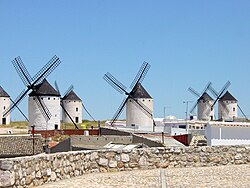La Mancha
| La Mancha | |
|---|---|
| Natural region | |

La Mancha's traditional windmills like these, still standing at Campo de Criptana were immortalized in the novel Don Quixote
|
|
 In red, location of the natural region of La Mancha. In dark gray, present-day Castilla–La Mancha autonomous community territories not included in historical La Mancha. |
|
| Country | Spain |
| Elevation | 610 m (2,000 ft) |
La Mancha (Spanish pronunciation: [la ˈmantʃa]) is a natural and historical region located on an arid but fertile, elevated plateau (610 m or 2000 ft.) of central Spain, south of Madrid, from the mountains of Toledo to the western spurs of the hills of Cuenca, and bordered to the South by the Sierra Morena and to the North by the Alcarria region. La Mancha includes portions of the modern provinces of Cuenca, Toledo, and Albacete, and most of the Ciudad Real province. La Mancha historical comarca constitutes the southern portion of Castilla–La Mancha autonomous community and makes up most of the present-day administrative region.
The name "La Mancha" is probably derived from the Arab word المنشا al-mansha, meaning "the dry land" or "wilderness". The name of the city of Almansa in Albacete also has the same origin. The word mancha in Spanish literally means spot, stain, or patch, but no apparent link exists between this word and the name of the region.
The largest plain in Spain, La Mancha is made up of a plateau averaging 500 to 600 metres in altitude (although it reaches 900 metres in Campo de Montiel and other parts), centering on the province of Ciudad Real. The region is watered by the Guadiana, Jabalón, Záncara, Cigüela, and Júcar rivers.
...
Wikipedia
